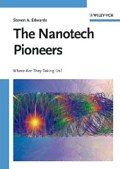Regular sciencebase visitors will be well aware of my interest in what keywords visitors use to either find the site or to search the site once they’re here. Four hits on the site this month were after Novel Prize controversy, again and again. I’m not sure what they hoped to find by adding that phrase “again and again”, but more to the point, I’m not aware of any Novel Prize. If they’re after the Nobel Prizes, then sciencebase offers a run down of those in Chemistry, Physics, and Medicine.
Author: David Bradley
Bird Flu Symptoms
 As Britain braces itself for the arrival of avian influenza from Continental Europe, I thought it would be timely to remind Sciencebase readers of a bird flu FAQ I wrote towards the end of last year to try and separate the facts from the fiction regarding H5N1 and the threat of a global bird flu pandemic.
As Britain braces itself for the arrival of avian influenza from Continental Europe, I thought it would be timely to remind Sciencebase readers of a bird flu FAQ I wrote towards the end of last year to try and separate the facts from the fiction regarding H5N1 and the threat of a global bird flu pandemic.
UPDATE: From Google.org – Each week, millions of users around the world search for online health information. As you might expect, there are more flu-related searches during flu season, more allergy-related searches during allergy season, and more sunburn-related searches during the summer. You can explore all of these phenomena using Google Trends. But can search query trends provide an accurate, reliable model of real-world phenomena?
By tracking search trends related to flu, Google now reckons it can predict the spread of the disease.
The Write Stuff
Australian scientists have compared evidence obtained using infrared spectroscopy with high-performance liquid chromatography coupled with a chemometrics analysis and demonstrated that this latter approach can distinguish between ballpoint pen inks much more effectively than IR alone. Read about this as well as other news with a spectroscopic bent in the latest updates from spectroscopynow.com including the A to Z of solar-powered nanomotors, and a fishy business in Croatia
Nanotech Pioneers
 It is on the nanometre scale where chemists, physicists, materials scientists and engineers, and even biologists will meet to create a new technology – nanotechnology. This book’s cover claims nanotech was “scarcely imagined a few decades ago”, but what about Fantastic Voyage, and, of course, Feynman’s predictions? Well, like they say, don’t judge a book by its cover. Nanotech is likely to dominate the 21st century and affect our lives in ways we have not yet determined. By definition, nanotech is far too small to be visible to the human eye, and so its effects may well catch us by surprise.
It is on the nanometre scale where chemists, physicists, materials scientists and engineers, and even biologists will meet to create a new technology – nanotechnology. This book’s cover claims nanotech was “scarcely imagined a few decades ago”, but what about Fantastic Voyage, and, of course, Feynman’s predictions? Well, like they say, don’t judge a book by its cover. Nanotech is likely to dominate the 21st century and affect our lives in ways we have not yet determined. By definition, nanotech is far too small to be visible to the human eye, and so its effects may well catch us by surprise.
Despite nanotech’s science fiction aura, consumer products already exist that rely on its earliest manifestations, although one has to say that most of these are not the nanotech of molecular machines, but generally just particles that are nanometres across or materials with nanoscale features that endow them with their particular properties.
The variety of new products and technologies that will spin out of nanoscience will, nevertheless be limited only by the imagination of the scientists, engineers and entrepreneurs drawn to this new field – The Nanotech Pioneers.
Steve Edwards presents nanotechnology and its leading makers in an easily understandable fashion, suited for all readers regardless of academic background, but with enough facts and details to separate the hype from the real nanotech that is just around the next corner. Edwards brings nanotechnology closer to the science-interested general public as well as scientists, students, organizations, journalists, politicians, and entrepreneurs.
Venture Capitalizing on Avian Flu Risk
According to the latest issue of FierceBiotech, just received in the Sciencebase office, venture capitalists are hoping to invest in bird flu. Apparently, Kleiner Perkins Caufield & Byers (they always have such long company names don’t they?) is starting a US$200 million life sciences fund to focus on new therapies against avian influenza ahead of a putative global pandemic. FierceBiotech reports that biopharma and university groups are to be steered towards this area of research with BioCryst Pharmaceuticals of Birmingham, first up for funding to help it develop its antiviral Peramivir.
Think Geek
I found a great site for all those gadgets that will make you the envy of the lab! Check out ThinkGeek gifts for geeks for hi-tech lights and lasers, Swiss Army USB knives, PIX Sports LED pedometer and message display, PowerSquid outlet multipliers, USB lava lamps (don’t ask!), wifi digital hotspot spotter, atomic dog tags (for supercool mutts with a penchant for retro chic), LED candles, and best of all – green laser pointers (beats those old-fashioned red ones on the lecture circuit any day).
And, as it’s my birthday today, feel free to send me any gadgety gift you like!
Loud Music Makes Ecstasy Worse

People taking ecstasy at noisy nightclubs could be doing themselves more harm than those who imbibe 3,4 -methylenedioxymethamphetamine (MDMA or ecstasy) at quieter locations.
Research published on February 16, in the journal BMC Neuroscience, shows that brain activity in MDMA-taking rats due to the drug lasts up to five days if the animals are listening to loud music, says a press release from BMC, when they ingest the drug. The drug’s effects wear off within a day when no music is played.
Actually, Michelangelo Iannone from the Institute of Neurological Science, Italy, and colleagues from University Magna Graecia in Catanzaro, Italy, do not report this at all. That’s just what the press release claims. In fact, the rats were exposed to white noise, random acoustic stimulation at 95 db. The press release explains that white noise is sound at a stable frequency that is used in many types of electronic music. Well, it is, usually to simulate the rythmic, “hissy”, bursts of the hi-hat cymbals in a drumkit, but it’s not usually a continuous sound.
Anyway, Iannone’s results show that low-dose MDMA did not modify the brain activity of the rats compared with saline, as long as no music was played. However, the total spectrum of the rats given a low dose of MDMA significantly decreased once loud music was played. The spectrum of rats in the control group was not modified by loud music. High-dose MDMA induced a reduction in brain activity, compared with both saline and low-dose MDMA. This reduction was enhanced once the loud music was turned on and lasted for up to five days after administration of the drug. In rats that had been given a high dose of MDMA but had not been exposed to music, brain activity returned to normal one day after administration of the drug.
Sliding Under
In Issue 33 of PSIgate Spotlight, I discuss new insights into the differences between the subduction zones where the Earth’s tectonic plates slide across each other. The research in questsion could help in earthquake prediction and allow seismologists to discover in advance whether an imminent earthquake will be weaker or as powerful as those that shook Indonesia in 2004, Alaska in 1964, Chile in 1960 and the Pacific Northwest United States in 1700.
Muscle and Musculature
I wrote a report for the UK’s Royal Society some time ago that continues to get a lot of visitors. The original report covers the mechanism of muscle contraction. Oddly though, most readers don’t bother reading parts 2 and 3 of this three-part report. Now, that’s either because they simply didn’t like my writing style or were bored by the article, but I like to think it is neither of those things and that visitors to that page are looking for something else.
What could that something else be? Well, it’s either pictures of people with muscles, or methods for making your own, I’m pretty sure. With that in mind, I searched the web for a decent publication that my readers could download and found this little gem. The book is called “Burn the Fat Feed the Muscle” and as the name may suggest it provides a program of top methods to help you shape up. As a regular gym goer, former squash player, cyclist and swimmer, I thought I knew most of what anyone needs to know about how to stay in shape, but BtFFtM’s author (unlike so many others) practices what he preaches and can back up his book with an impeccable track record, and I reckon anyone can find remove for improvement whatever their fitness level.
I’m only going to leave this link in my blog for a week or so, so if you’re one of the dozens of people looking to shape up those muscles who hit my muscle science pages, then grab the ebook while it’s live.
Download – Burn the fat feed the muscle
Uber Pluto

New measurements published earlier this month support recent claims that the planetary membership of our Solar System should be extended to include a tenth that is bigger than Pluto. 2003 UB313 was first spotted in January 2005 by Mike Brown’s team at Caltech, but recent thermal emission measurements have recently allowed German scientists to estimate its diameter at approximately 3100 km, some 700 km larger than Pluto. This makes it the biggest object to be discovered in the solar system since the discovery of Neptune in 1846. For comparison, Earth’s Moon has a diameter of about 3500 km.
Get the new spin in my : Spotlight Science News column on PSIgate.